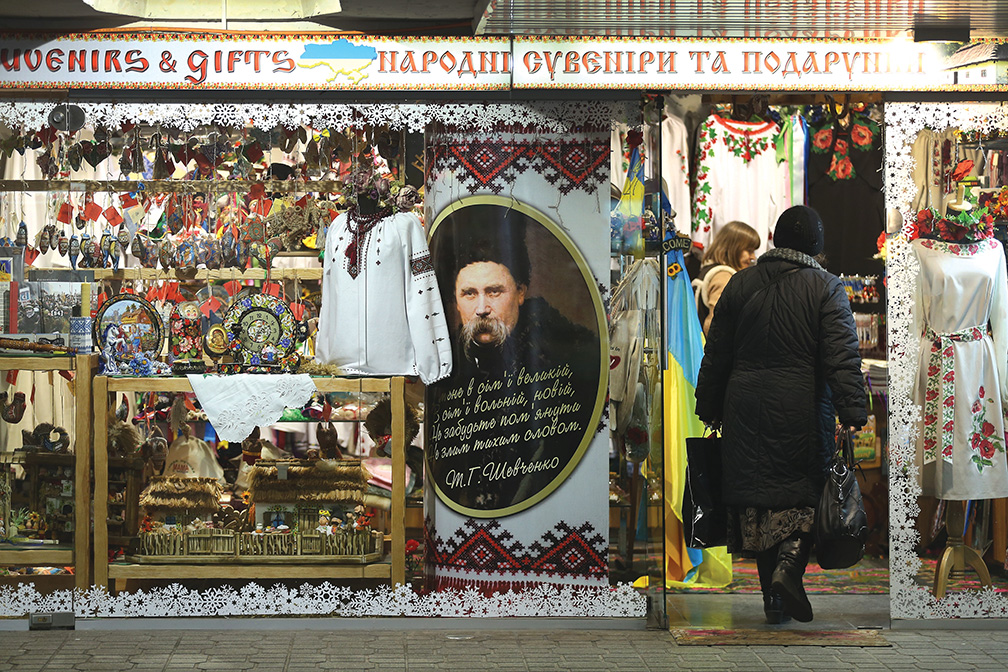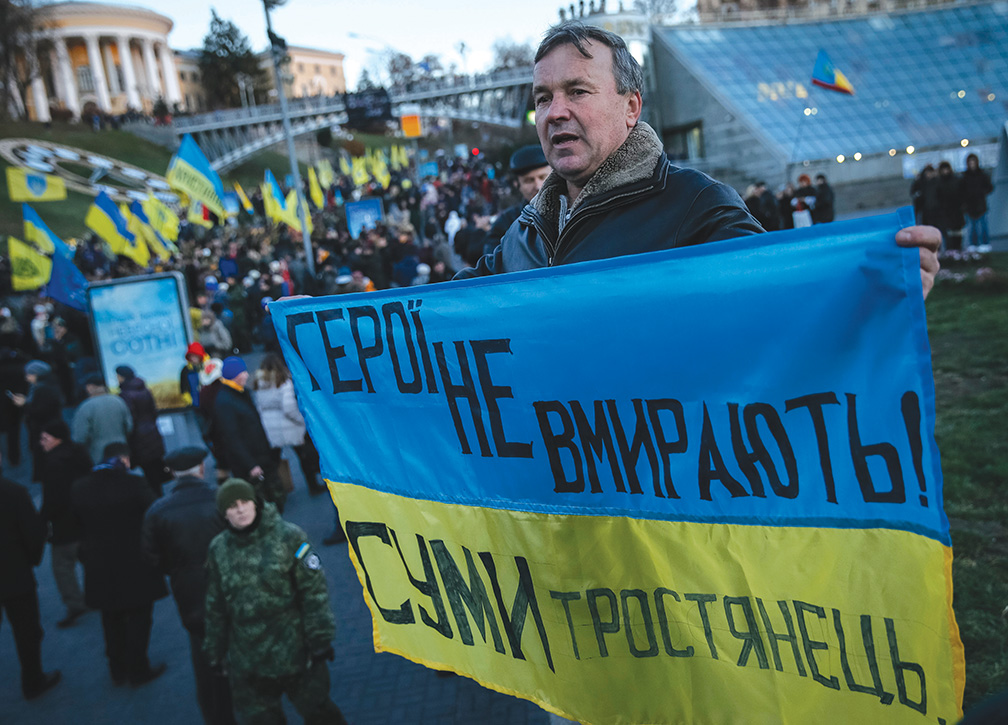Russia’s romantic attachment to its Soviet past has colored its relationship With Ukraine
By Tobias Oder, Marshall Center
The crisis in Ukraine has taken a toll on Eastern Europe’s future regional security, as well as global security. Not only has it resulted in major changes in international politics, such as the exclusion of Russia from the G8 and a deterioration of Russian-American relations to levels seen at the end of Cold War, but it also has made a significant impact on a wide range of humanitarian and regional security issues. What started as a Ukrainian struggle for regime change has led to a civil war with Russian involvement and the internal displacement of up to 1.2 million people.
While political theorists attempt to identify causes for the crisis in major shifts in the global political landscape, such as the European Union’s and NATO’s continued eastern enlargement, these approaches are often shortsighted and fail to take historical and ideological causes into account. As we look at the underlying conflict lines in eastern Ukraine and different arguments on both the Russian and Ukrainian sides, it becomes clear this conflict can be characterized as a clash of conflicting identities and narratives.
Identities serve as orientation points for civilizations, helping them interpret reality through different narratives. This is why people interpret the same event differently. It is because they view a story — a material reality — through a certain, constructed, cultural lens influenced by norm structures, traditions, narratives and morals. For example, an American usually perceives Israeli nuclear weapons differently than an Iranian does, based on different interpretations of the Israeli state.

These different narratives serve as a foundation for national identities. By establishing multiple shared narratives regarding certain events in history and ongoing processes in the present, identities give a pervading definition of self-perception. This is why identities primarily give an answer to the question: “Who am I?” However, for identities to answer this question, they also have to define: “Who are the others?” That being said, identities not only serve as a point of self-definition, but also define a perception of populations and other societies that exist outside of the subject’s own community. Conflict can emerge when two identities are incompatible with each other, which happens when narratives oppose each other on essential issues.
The crisis in Ukraine has unveiled essential differences in Russian and Ukrainian identities, mostly concerning conflicting narratives of their shared history and also ongoing events. During the course of the crisis, the conflicting parties use historical narratives to appeal to national identities to support their causes and legitimize courses of action. Since a national identity not only supplies a sense of self, but also defines other populations, two conflict lines emerged in the current crisis: first, a conflict between how Russia views itself and its past and how Ukraine defines Russia and its past, and second, a conflict between how Ukraine views itself and how Russia defines Ukraine.
The case of Russia
Russia’s self-perception, its national identity and historical narratives, plays a big role in understanding its actions in the Ukraine crisis. Russia’s national identity is largely linked to its Soviet past. The collapse of the Soviet Union caused a severe identity crisis in Russia, fueled by the regional disintegration of former Soviet republics such as Ukraine and other nations that are now a part of the EU and/or NATO. For many Russians, this meant losing considerable influence in its former republics.
This chaos of the 1990s has led many Russians to mourn the collapse of the USSR for many reasons, whether it be personal incompatibility with the new economic system or nostalgia for and pride in the Soviet Union’s former great power status. Contemporary Russian identity is largely framed by the presidency of Vladimir Putin, who introduced a new concept of Russian national pride. It emphasizes Russia’s great cultural achievements, for example, by celebrating authors such as Tolstoy and composers such as Tchaikovsky. Accordingly, it has become common to refer to Russia’s glorious past, whether it means stressing cultural achievements, the glories of the Russian Empire or the great power stature of the Soviet Union and its influence over Eastern Europe. Putin’s new “conservative values” program gave Russia’s population the strong self-identification it so desperately sought after the dissolution of the Soviet Union.

Russia’s national pride can be observed in its newly adapted neighborhood policy. By embracing its former “glorious past,” it emphasizes the concept of Russkiy mir, or the Russian world. This refers to regions that share a history with Russia, mostly during Soviet days. Part of the Russian narrative is that these regions are not necessarily Russia itself, but part of the Russian orbit. By stressing cultural commonalities like language, religion or history, Russia draws a picture of Eastern Europe as being inseparably connected to Russia. The next step in this logical causality is the assertion that these shared narratives give Russia a legitimate claim to influence the region.
The Russkiy Mir Foundation, often referred to as Russia’s “soft power” agency, states: “The Russian world is much more than the territory of the Russian Federation and the 143 million people living within its borders.” So, by perceiving certain parts of Eastern Europe, including specific parts of Ukraine, as the “Russian world” and by viewing Russian-speaking Ukrainians, for example, as ethnic Russians, Putin’s actions in eastern Ukraine are rendered legitimate from a Russian perspective. The narrative includes protecting ethnic Russians from a supposedly fascist, anti-Russian government in Kiev that wants to ban the Russian language from its society. Putin has shown to be prone to this narrative by referring to Ukraine as “not a real state” and by his statement that the “historical South of Russia” was added to Ukraine “with no consideration for the ethnic makeup of the population.” After all, the bottom line for Russia’s action in Ukraine is the idea that eastern Ukraine is a vital part of the Russian world, with a 94 percent Russian-speaking population.
The case of Ukraine
However, the process of forming a Ukrainian identity resulted in creating narratives that disagree, to a great extent, with Russian perceptions of the Soviet Union, Ukrainian independence and the future of Eastern Europe. Even though the process of developing a Ukrainian identity was slow, the young generation of Ukrainians predominantly defines itself as “Ukrainian” and emancipated itself from a Russian-dominated identity, imposed on Ukrainians from Russia.
It is often suggested that Ukraine, or at least part of it, does not have a strong national identity because of its Russian past and large Russian-speaking population. After all, 94 percent of eastern Ukrainians list Russian as the easier language of communication. However, it is a false conclusion to assume that Russian speakers in eastern Ukraine feel they are ethnic Russians. When asked their nationality, 72 percent of eastern Ukrainians said “Ukrainian,” and 93 percent considered Ukraine their motherland, according to a poll conducted by the Razumkov Centre. So even though the Russian language still plays a big role in Ukrainian society and a large part of the Ukrainian population prefers friendly relations with Russia, this should not be misinterpreted as a Russian self-perception in Ukraine.
This contrasts with the Russian perception of Ukraine as a part of the larger Russian world. That concept holds true language-wise, but it is here where the two identities collide. While Russia defines a Russian population based on its language, it conflicts with Ukrainian self-perception, which defines itself by national feeling. The basic underlying difference is the narrative of defining the affiliation of a population: The Russian narrative is that language is the crucial variable in defining a population, while the Ukrainian narrative emphasizes a collective national identity.
Moreover, the Ukrainian national identity narrative is based on independence from Russia. This is mostly based on a different narrative and interpretation of the Soviet past, which is not seen as a time of glory in Ukraine, but rather as a time of oppression and subjugation. The case of the Holodomor is one example of the conflict between Ukraine and Russia. While Ukraine has officially recognized the Holodomor as genocide against the Ukrainian people, Russia still rejects this position. This symbolizes the negative attitude of Ukraine toward the Soviet era, which is why it is an important aspect of Ukrainian national identity to emphasize Ukraine’s opposition to Russia as a successor of the Soviet Union. However, there are also tendencies in Ukraine’s identity that point toward being fundamentally anti-Russian and characterize Russia as “the opposite of Europe, democracy and civilization.”
It should be noted, however, that hostile identities alone do not cause conflict. They are merely the foundation on which conflict can be constructed. For these latent conflict structures to turn violent, it requires purposeful action by so-called “conflict entrepreneurs” to exploit the different identities and render violent action reasonable. This happened on both sides of the conflict through different measures such as creating victimhood — either of ethnic Russians or independent Ukraine — or the dehumanization of the other. The point being, once identity structures are exposed to violent conflict, it is hard to create a sustainable peace agreement without one party experiencing loss of face.
For a peace agreement to succeed in the region, all conflicting parties have to be genuinely committed to creating a peaceful coexistence. The culture of violence created during the past year has to be deconstructed by emphasizing the importance of a peaceful solution. Beyond that, attempts to resolve conflict cannot solely focus on one point, like an immediate cease-fire, but also have to deal with the identity structures that represent the frame of the conflict. This means that both sides have to adapt more peaceful rhetoric with respect to the other to work together toward finding a common approach to peaceful coexistence. This can be achieved through more vital cultural exchanges between Ukrainian and Russian civil societies that contribute to mutual understanding, deconstruction of hostile sentiments and peaceful management of disagreements.
Conclusion
To sum up, the crisis in Ukraine is based on two different narratives of how Eastern Europe looks, or is supposed to look. While Russia adapted conservative romanticism in respect to its great power status and wants to regain its former influence in the region by unifying the Russian-speaking population under Moscow’s umbrella, Ukraine views the collapse of the Soviet Union as a manifestation of independence and has since developed a strong sense of self-perception. Even the Russian-speaking population of Ukraine feels more drawn to Ukraine than to Russia.
That being said, this crisis predominantly stems from Russia defining Ukraine very differently than Ukraine defines itself, which can be observed in conflicting narratives on the same issues. One of the overarching conflict lines, for instance, concerns the concept of Russkiy mir and the Russian claim to have legitimate spheres of influence in post-Soviet countries with Russian-speaking populations — which conflicts with the Ukrainian self-understanding of independence. This makes Russian involvement in eastern Ukraine a mission to protect ethnic Russians, from Moscow’s perspective, and an illegitimate interference with Ukraine’s sovereignty, from Kiev’s perspective. As long as both nations fail to find a common narrative and establish nonhostile identities toward one another, these conflict lines will remain entrenched.


Comments are closed.